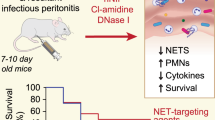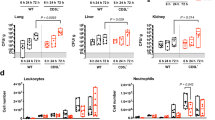Abstract
Background
Escherichia coli and Group B streptococci (GBS) are the main causes of neonatal early-onset sepsis (EOS). Despite antibiotic therapy, EOS is associated with high morbidity and mortality. Dual inhibition of complement C5 and the Toll-like receptor co-factor CD14 has in animal studies been a promising novel therapy for sepsis.
Methods
Whole blood was collected from the umbilical cord after caesarean section (n = 30). Blood was anti-coagulated with lepirudin. C5 inhibitor (eculizumab) and anti-CD14 was added 8 min prior to, or 15 and 30 min after adding E. coli or GBS. Total bacterial incubation time was 120 min (n = 16) and 240 min (n = 14). Cytokines and the terminal complement complex (TCC) were measured using multiplex technology and ELISA.
Results
Dual inhibition significantly attenuated TCC formation by 25-79% when adding inhibitors with up to 30 min delay in both E. coli- and GBS-induced inflammation. TNF, IL-6 and IL-8 plasma concentration were significantly reduced by 28–87% in E. coli-induced inflammation when adding inhibitors with up to 30 min delay. The dual inhibition did not significantly reduce TNF, IL-6 and IL-8 plasma concentration in GBS-induced inflammation.
Conclusion
Dual inhibition of C5 and CD14 holds promise as a potential future treatment for severe neonatal EOS.
Impact
-
Neonatal sepsis can cause severe host inflammation with high morbidity and mortality, but there are still no effective adjunctive immunologic interventions available.
-
Adding CD14 and complement C5 inhibitors up to 30 min after incubation of E. coli or Group B streptococci in a human umbilical cord blood model significantly reduced complement activation and cytokine release.
-
Dual inhibition of C5 and CD14 is a potential future therapy to modulate systemic inflammation in severe cases of neonatal sepsis.
This is a preview of subscription content, access via your institution
Access options
Subscribe to this journal
Receive 14 print issues and online access
$259.00 per year
only $18.50 per issue
Buy this article
- Purchase on Springer Link
- Instant access to full article PDF
Prices may be subject to local taxes which are calculated during checkout





Similar content being viewed by others
Data availability
The data sets generated during and/or analysed during the current study are available from the corresponding author on reasonable request.
References
Vergnano, S., Sharland, M., Kazembe, P., Mwansambo, C. & Heath, P. Neonatal sepsis: an international perspective. Arch. Dis. Child. Fetal Neonatal Ed. 90, F220–F224 (2005).
Oza, S., Lawn, J. E., Hogan, D. R., Mathers, C. & Cousens, S. N. Neonatal Cause-of-death estimates for the early and late neonatal periods for 194 countries: 2000–2013. Bull. World Health Organ. 93, 19–28 (2014).
Stoll, B. J. et al. Early-onset neonatal sepsis 2015 to 2017, the rise of Escherichia coli, and the need for novel prevention strategies. JAMA Pediatr. 174, e200593 (2020).
Flannery, D. D., Edwards, E. M., Puopolo, K. M. & Horbar, J. D. Early-onset sepsis among very preterm infants. Pediatrics 148, e2021052456 (2021).
Wynn, J., Cornell, T. T., Wong, H. R., Shanley, T. P. & Wheeler, D. S. The host response to sepsis and developmental impact. Pediatrics 125, 1031–1041 (2010).
Hajishengallis, G., Reis, E. S., Mastellos, D. C., Ricklin, D. & Lambris, J. D. Novel mechanisms and functions of complement. Nat. Immunol. 18, 1288–1298 (2017).
Pietrocola, G. et al. The group B streptococcus–secreted protein Cip interacts with C4, preventing C3b deposition via the lectin and classical complement pathways. J. Immunol. 196, 385–394 (2016).
Ward, P. A. The dark side of C5a in sepsis. Nat. Rev. Immunol. 4, 133–142 (2004).
De Jong, H. K., Van Der Poll, T. & Wiersinga, W. J. The systemic pro-inflammatory response in sepsis. J. Innate Immun. 2, 422–430 (2010).
Gabay, C. & Kushner, I. Acute-phase proteins and other systemic responses to inflammation. N. Engl. J. Med. 340, 448–454 (1999).
Chauhan, N., Tiwari, S. & Jain, U. Potential biomarkers for effective screening of neonatal sepsis infections: an overview. Microb. Pathog. 107, 234–242 (2017).
Barratt‐Due, A., Pischke, S. E., Nilsson, P. H., Espevik, T. & Mollnes, T. E. Dual inhibition of complement and toll‐like receptors as a novel approach to treat inflammatory diseases—C3 or C5 emerge together with CD14 as promising targets. J. Leukoc. Biol. 101, 193–204 (2017).
Schüller, S. S. et al. Immunomodulation to prevent or treat neonatal sepsis: past, present, and future. Front. Pediatr. 6, 199 (2018).
Wynn, J. L. & Levy, O. Role of innate host defenses in susceptibility to early-onset neonatal sepsis. Clin. Perinatol. 37, 307–337 (2010).
Nilsen, N. J. et al. Cellular trafficking of lipoteichoic acid and toll‐like receptor 2 in relation to signaling; role of CD14 and CD36. J. Leukoc. Biol. 84, 280–291 (2008).
Lotz, S. et al. Highly purified lipoteichoic acid activates neutrophil granulocytes and delays their spontaneous apoptosis via CD14 and TLR2. J. Leukoc. Biol. 75, 467–477 (2004).
Skjeflo, E. W., Christiansen, D., Espevik, T., Nielsen, E. W. & Mollnes, T. E. Combined inhibition of complement and CD14 efficiently attenuated the inflammatory response induced by Staphylococcus aureus in a human whole blood model. J. Immunol. 192, 2857–2864 (2014).
Puopolo, K. M., Benitz, W. E., Zaoutis, T. E. & Diseases, C. O. I. Management of neonates born at ≥ 35 0/7 weeks’ gestation with suspected or proven early-onset bacterial sepsis. Pediatrics 142, e20182894 (2018).
Klingenberg, C., Kornelisse, R. F., Buonocore, G., Maier, R. F. & Stocker, M. Culture-negative early-onset neonatal sepsis—at the crossroad between efficient sepsis care and antimicrobial stewardship. Front. Pediatr. 6, 285 (2018).
Brekke, O.-L. et al. Combined inhibition of complement and CD14 abolish E. coli-induced cytokine-, chemokine-and growth factor-synthesis in human whole blood. Mol. Immunol. 45, 3804–3813 (2008).
Thorgersen, E. B. et al. Inhibition of complement and CD14 attenuates the Escherichia coli-induced inflammatory response in porcine whole blood. Infect. Immun. 77, 725–732 (2009).
Egge, K. H. et al. Post challenge inhibition of C3 and CD14 attenuates Escherichia coli-induced inflammation in human whole blood. Innate Immun. 20, 68–77 (2014).
Egge, K. H. et al. The anti-inflammatory effect of combined complement and CD14 inhibition is preserved during escalating bacterial load. Clin. Exp. Immunol. 181, 457–467 (2015).
Lau, C. et al. Chimeric anti-CD14 IgG/4 hybrid antibodies for therapeutic intervention in pig and human models of inflammation. J. Immunol. 191, 4769–4777 (2013).
Mollnes, T. E. et al. Essential role of the C5a receptor in E. coli–induced oxidative burst and phagocytosis revealed by a novel lepirudin-based human whole blood model of inflammation. Blood 100, 1869–1877 (2002).
Bergseth, G. et al. An international serum standard for application in assays to detect human complement activation products. Mol. Immunol. 56, 232–239 (2013).
Schlapbach, L. J. et al. Differential role of the lectin pathway of complement activation in susceptibility to neonatal sepsis. Clin. Infect. Dis. 51, 153–162 (2010).
Eisen, D. P. & Minchinton, R. M. Impact of mannose-binding lectin on susceptibility to infectious diseases. Clin. Infect. Dis. 37, 1496–1505 (2003).
Harboe, M., Thorgersen, E. B. & Mollnes, T. E. Advances in assay of complement function and activation. Adv. Drug Deliv. Rev. 63, 976–987 (2011).
Zhao, X., Chen, Y.-X. & Li, C.-S. Predictive value of the complement system for sepsis-induced disseminated intravascular coagulation in septic patients in emergency department. J. Crit. Care 30, 290–295 (2015).
Raymond, S. L. et al. Immunological defects in neonatal sepsis and potential therapeutic approaches. Front. Pediatr. 5, 14 (2017).
Mohamed, M. A., Cunningham-Rundles, S., Dean, C. R., Hammad, T. A. & Nesin, M. Levels of pro-inflammatory cytokines produced from cord blood in-vitro are pathogen dependent and increased in comparison to adult controls. Cytokine 39, 171–177 (2007).
Østerholt, H. C., Lundeland, B., Sonerud, T., Saugstad, O. D. & Nakstad, B. The impact of hyaluronan on monocyte toll‐like receptor expression in term infant cord blood. Acta Paediatr. 101, 706–713 (2012).
Tatad, A. F. et al. Cytokine expression in response to bacterial antigens in preterm and term infant cord blood monocytes. Neonatology 94, 8–15 (2008).
Krueger, M. et al. Cord blood levels of interleukin-6 and interleukin-8 for the immediate diagnosis of early-onset infection in premature infants. Neonatology 80, 118–123 (2001).
Büscher, U. et al. IL-1β, IL-6, IL-8 and G-CSF in the diagnosis of early-onset neonatal infections. J. Perinat. Med. 28, 383–388 (2000).
Berner, R., Welter, P. & Brandis, M. Cytokine expression of cord and adult blood mononuclear cells in response to Streptococcus agalactiae. Pediatr. Res. 51, 304–309 (2002).
Kashlan, F. et al. Umbilical vein interleukin 6 and tumor necrosis factor alpha plasma concentrations in the very preterm infant. Pediatr. Infect. Dis. J. 19, 238–243 (2000).
Garred, P., Tenner, A. J. & Mollnes, T. E. Therapeutic targeting of the complement system: from rare diseases to pandemics. Pharmacol. Rev. 73, 792–827 (2021).
Keshari, R. S. et al. Inhibition of complement C5 protects against organ failure and reduces mortality in a baboon model of Escherichia coli sepsis. Proc. Natl Acad. Sci. USA 114, E6390–E6399 (2017).
Reiss, U. M. et al. Efficacy and safety of eculizumab in children and adolescents with paroxysmal nocturnal hemoglobinuria. Pediatr. Blood Cancer 61, 1544–1550 (2014).
Greenbaum, L. A. et al. Eculizumab is a safe and effective treatment in pediatric patients with atypical hemolytic uremic syndrome. Kidney Int. 89, 701–711 (2016).
Olszyna, D. P. et al. Effect of IC14, an anti‐CD14 antibody, on plasma and cell‐associated chemokines during human endotoxemia. Eur. Cytokine Netw. 14, 158–162 (2003).
Huber-Lang, M. et al. Double blockade of CD14 and complement C5 abolishes the cytokine storm and improves morbidity and survival in polymicrobial sepsis in mice. J. Immunol. 192, 5324–5331 (2014).
Skjeflo, E. W. et al. Combined inhibition of complement and CD14 improved outcome in porcine polymicrobial sepsis. Crit. Care 19, 1–8 (2015).
Nakstad, B., Sonerud, T. & Solevåg, A. L. Early detection of neonatal group B Streptococcus sepsis and the possible diagnostic utility of IL-6, IL-8, and CD11b in a human umbilical cord blood in vitro model. Infect. Drug Resist. 9, 171 (2016).
Eichberger, J., Resch, E. & Resch, B. Diagnosis of neonatal sepsis: the role of inflammatory markers. Front. Pediatr. 10, 840288 (2022).
Mathews, J. H., Klesius, P. H. & Zimmerman, R. A. Opsonin system of the group B Streptococcus. Infect. Immun. 10, 1315–1320 (1974).
Draper, D. W., Bethea, H. N. & He, Y.-W. Toll-like receptor 2-dependent and-independent activation of macrophages by Group B Streptococci. Immunol. Lett. 102, 202–214 (2006).
Acknowledgements
We thank all participating mothers for their contributions to this study and the personnel at the Department of Obstetrics at University Hospital of North Norway for important collaboration and help to organise the study.
Funding
The first author was funded by UiT-The Arctic University of Norway as a medical research student.
Author information
Authors and Affiliations
Contributions
Substantial contributions to conception and design, acquisition of data, or analysis and interpretation of data: A.U.B., H.N.G., J.P.C., I.H., J.K.L., C.L., T.E., T.E.M., C.K. Drafting the article: A.U.B. and C.K. Critically revised the manuscript and approved the final version to be published: all authors.
Corresponding author
Ethics declarations
Competing interests
The authors declare no competing interests.
Ethics approval and consent to participate
The study was approved by the Regional Ethical Committee (2019/834/REK nord). All participating women gave informed written consent to participate in the study. All participants signed a written consent.
Additional information
Publisher’s note Springer Nature remains neutral with regard to jurisdictional claims in published maps and institutional affiliations.
Supplementary information
Rights and permissions
Springer Nature or its licensor (e.g. a society or other partner) holds exclusive rights to this article under a publishing agreement with the author(s) or other rightsholder(s); author self-archiving of the accepted manuscript version of this article is solely governed by the terms of such publishing agreement and applicable law.
About this article
Cite this article
Bjerkhaug, A.U., Granslo, H.N., Cavanagh, J.P. et al. Dual inhibition of complement C5 and CD14 attenuates inflammation in a cord blood model. Pediatr Res 94, 512–519 (2023). https://doi.org/10.1038/s41390-023-02489-2
Received:
Revised:
Accepted:
Published:
Issue Date:
DOI: https://doi.org/10.1038/s41390-023-02489-2



